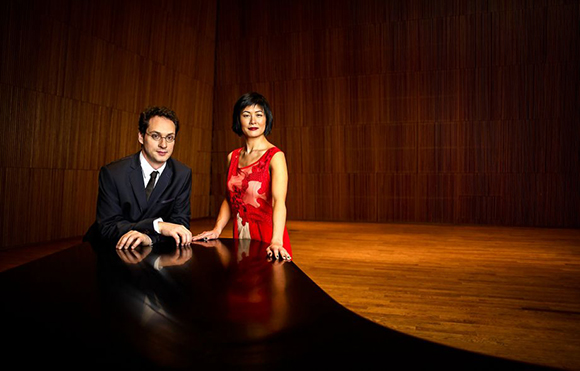The Wall Street Journal
By Barbara Jepson
November 16, 2015
original
link
‘Bridge to Beethoven’ Review: Where Old Meets New
Leading composers react to Beethoven’s violin sonatas.

Jennifer Koh and Shai Wosner (Photo by Jürgen Frank)
New York and San Francisco
Composers over the centuries have found inspiration in a plethora of sources—folk songs, literary texts and even, recently, income-inequality charts. “Bridge to Beethoven,” an intriguing four-part series being presented this season in New York and San Francisco, and elsewhere in smaller segments, offers another creative stimulus.
Developed by the vibrant violinist Jennifer Koh in collaboration with the insightful pianist Shai Wosner, “Bridge to Beethoven” journeys beyond the coupling of old and new for which both performers are known. Ms. Koh commissioned three noteworthy American composers— Vijay Iyer, Andrew Norman and Anthony Cheung—to write companion pieces for specific violin sonatas by Beethoven she selected. Mr. Wosner recommended a suitable existing work by the admirable German composer Jörg Widmann.
Each concert will contain one contemporary piece and two or three Beethoven violin sonatas. He wrote 10 of them for violin and accompanying piano. They are noted for their sudden key shifts, dynamic contrasts and equal treatment of both instruments.
Beethoven was a towering genius, and some critics have suggested it’s unwise to juxtapose new works with past masterpieces. But all compositions should be judged by the same standards, and the two contemporary works I heard added immeasurably to the concert experience. I do wonder, however, about the efficacy of asking composers to respond to pieces chosen for them, rather than having the impetus for homage come from within.
The first program, to be repeated on Nov. 18 at Pickman Hall in Cambridge, Mass., was heard in the charming folk-art ambiance of the intimate Buttenwieser Hall at New York’s 92nd Street Y. After a congenial rendering of Beethoven’s D Major Violin Sonata, Op. 12, his first effort in that genre, came the heart of the program: Mr. Iyer’s “Bridgetower Fantasy,” followed by Beethoven’s monumental “Kreutzer” Sonata. The latter is noted for its groundbreaking structural and expressive content, which travels far from 18th-century salon music.
“Bridgetower Fantasy” for violin and piano is an extended riff on the mercurial character traits ascribed by Beethoven to the Afro-European violinist George Bridgetower, the sonata’s originally intended dedicatee. (Following the premiere, the two men had a falling out, and Beethoven later dedicated the work to Rodolphe Kreutzer, who never played it.)
Like the “Kreutzer,” Mr. Iyer’s piece begins slowly, then increases in tempo. About 17 minutes long in this performance, it opens with Mr. Wosner producing thumps with the piano’s sustaining pedal and other percussive effects while Ms. Koh plays wispy harmonics in the violin stratosphere. Written in a loosely atonal idiom, “Fantasy” veers from sparse repeated tones and lyric shards to propulsive rhythms. After a middle section that gives the performers some improvisational freedom, the engaging finale builds fitfully to a manic, whirling-dervish ending, matching the intensity, if not the inspiration, of the “Kreutzer” Sonata’s weighty first movement. Ms. Koh’s command of the various bowing techniques required was breathtaking.
In the performance of the “Kreutzer,” Mr. Wosner’s intelligent phrasing and singing tone were a real asset. Some violinists bring more finesse to this sonata’s rapid downscale runs, but Ms. Koh caught its revolutionary spirit, as well as the latent sadness of the second movement’s F minor variation.
The second program of “Bridge to Beethoven” was presented in San Francisco by San Francisco Performances at the elegant, 930-seat Herbst Theatre. One highlight of this concert, to be heard on Dec. 7 at the Y in New York, was Beethoven’s A Major Violin Sonata, Op. 12. The musicians listened intently to each other and communicated the piece’s subtle mood shifts. The tuneful “Spring” Sonata was properly buoyant, although more dynamic shadings and expressivity would have enhanced Ms. Koh’s contributions.
The other highlight was the first movement of Mr. Widmann’s “Sommersonate.” Unveiled at the BeethovenFest Bonn in 2010, it explores the sonata tradition, especially the works of you-know-who. (There is now a second movement; hopefully a third will be forthcoming.) About 20 minutes in length, “Sommersonate” is by turns wistful, sprightly, fierce and impassioned, particularly in the piano, which occasionally bursts into surging melody accompanied by pounding chords. It’s as if the composer has a Romantic alter ego struggling to be heard amid the chromatic musical language. Most impressively, the way Mr. Widmann adroitly unifies several recurring thematic fragments into an organic whole is very Beethoven-like.
The performance was first-rate, with both musicians giving their all. Ms. Koh dispatched the bravura passages as if they were child’s play.
It will be interesting to see if these fine musicians continue to program the contemporary works chosen for “Bridge to Beethoven” in future seasons, and, more significantly, if other performers espouse them as well. I suspect Mr. Widmann’s piece will last.
Ms. Jepson writes about classical music for the Journal and co-edits the website Classical Voice North America.
Copyright ©2015 The Wall Street Journal
© Jennifer Koh, All Rights Reserved. Photography by Juergen Frank. Site by ycArt design studio